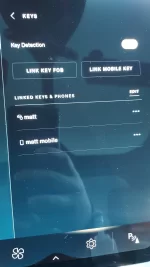Unfortunately, my optimism was premature. I just did another test drive to see how things were behaving, and there were new problems plus the old ones returning.
When I got into the car, I decided to reposition the steering wheel a bit. When I hit the "Save to Profile" button, the car shut down. All the screens went black, the A/C stopped, and the car rebooted.
After the reboot, I called up music via Alexa and got what I requested. (I was on the WiFi signal in the garage.)
I backed out of the garage and brought up the Homelink icon to close the door. The door came down about two feet and then went back up, and I saw the overhead light was blinking, indicating that Homelink had somehow put the door opener into programming mode. Each time I tried the Homelink button, the door would come down the two feet and then go back up. I switched to the old remote I keep in the car, but the problem continued. Finally, I pulled around the driveway circle so that the car was not aimed at the door, and I the old remote succeeded in closing the door. (The Homelink function was the only thing the techs seemed to have been able to fix when they were here two days ago.) When I returned home and tried to open the door using Homelink, the door operated normally.
After this little drama, I drove off. When I moved beyond WiFi range of the house, the music stopped. I continued to drive, waiting for the system to switch to the LTE signal as it had done this morning. It never did. Finally, I went into settings and manually turned off WiFi and was then able to get Alexa to bring up another music selection. I then tried making several phones calls through Alexa, as I had three bars of signal strength. Twice Alexa said "calling on this phone is not supported by Alexa", and once it said "I cannot find the contact for P_____ P _______ (correctly saying back to me the name I had given). I continued trying to place calls to various people throughout the drive as I moved through areas of different signal strength, but Alexa persisted in giving me those two messages.
So, today's results: one step forward this morning and two steps back this afternoon.

